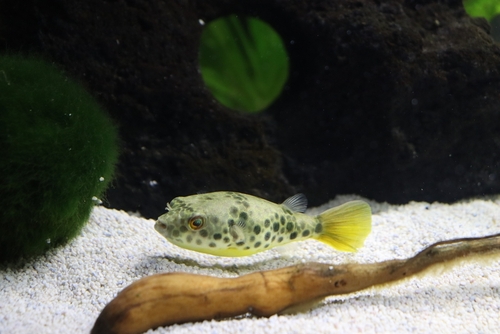Wondering who could join your Leopard Puffer Fish in the aquarium safely? Take a look at the 15 Best Leopard Puffer Tank Mates!
The 15 Best Leopard Puffer Tank Mates include other fish of comparable size, or even smaller sizes, as long as there is enough room in the tank. These can include monos, mollies, and even gobies. As long as the fish have similar temperaments, acceptable sizes, and identical tank parameters, they will be fine as companions to the puffer fish!
In this article, we will provide our list of the 15 Best Leopard Puffer Tank Mates and what makes each of these special, as well as some common information necessary to know when picking out tank mates for this fish. Let’s get started!
Contents
Leopard Puffer Tank Mates – What You Need to Know
There is plenty of information to know when being responsible for any fish, but when it comes to tank mates for the leopard puffer, the information below should be prioritized!
Temperament
The temperament of a leopard puffer fish is, unfortunately, pretty aggressive. This means that just like human beings, this fish will not get along with just any roommate! You’ll need to find a bunch of fish that can stand up for themselves rather than be bullied or even eaten by the leopard puffer.
Size
Leopard puffers are able to grow up to 6.7 inches. Though this may not seem terribly large, they will need a minimum tank size of about 30 gallons. All tank mates should be at least 6 inches if not even bigger than this aggressive puffer.
Competition
Leopard puffers are mainly carnivorous, which is why it is not advisable to have smaller fish that are too slow to escape the leopard puffer or don’t have enough room to get away when the puffer is hungry.
Additionally, if a fish has a diet that is too similar to that of the leopard puffer, they could compete and wind up starving one another.
Parameters ; Tank Setup
The leopard puffer enjoys plants and rocks for hiding in, but ultimately, having too cramped a space will make the leopard puffer resort to biting and trying to eat other fish to make room, so 55 gallons is the safest size.
The best is between 74 degrees and 78 degrees Fahrenheit in terms of temperature.
15 Best Leopard Puffer Tank Mates
- Clown Fish
- Damselfish
- Lemon Cichlid
- Guppy
- Archerfish
- Sailfin Molly
- Orange Chromide
- Leaf Fish
- Mudskipper
- Figure 8 Puffer
- Neon Goby
- Wrestling Halfbeak
- Flower Horn Cichlid
- Balloon Molly
- Dalmatian Molly
Let’s examine each of these fish more closely to see which may be right for your and right for your leopard puffer fish!
You also shouldn’t miss these other related posts:
- Bumblebee Cichlid Tank Mates
- Cardinal Tetra Tank Mates
- Hillstream Loach Tank Mates
- Red Claw Crab Tank Mates
1. Clown Fish
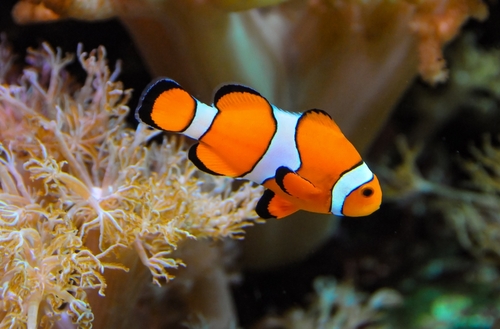
- Scientific Name: Amphiprion ocellaris
- Adult Size: 3.5 inches
- Compatible With: Leopard Puffer
- Care Level: Easy
- Origin: Northern Australia, Indo-Pacific
The clown fish is one of the most popular fish in the deep blue sea! It makes a great companion to the leopard puffer not only because it can survive in brackish water also, but because it is big and clever enough to defend itself.
Though many already know the description of a clownfish, if you’ve never had the pleasure of seeing one, you should know that it is a round fish colored mostly in orange with three to four broad white stripes.
Pros of keeping with Leopard Puffer:
- No food competition
- Large Enough to avoid being eaten
Cons of keeping with Leopard Puffer :
- None
2. Damselfish
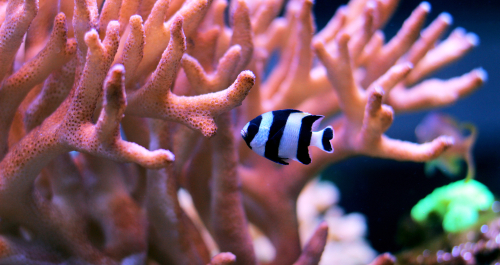
- Scientific Name: Stegastes Ieucorus
- Adult Size: 3 inches
- Compatible With: Leopard Puffer
- Care Level: Easy
- Origin: Pacific Ocean
A damsel fish is a popular fish to have, not only because it exists in brackish water like the puffer, but because it is fun to watch! That being said, though this fish may be fine with a puffer as long as it has a shoal of its own to keep to, it is normally aggressive with tank mates.
Damsel fish are named “whitetail damsels” because of the markings on their fins, and are otherwise a muted, velvety purple to gray color all over.
Pros of keeping with Leopard Puffer:
- No food competition
- May not be eaten when in a shoal
Cons of keeping with Leopard Puffer :
- Chance of aggression with tank mates
3. Lemon Cichlid
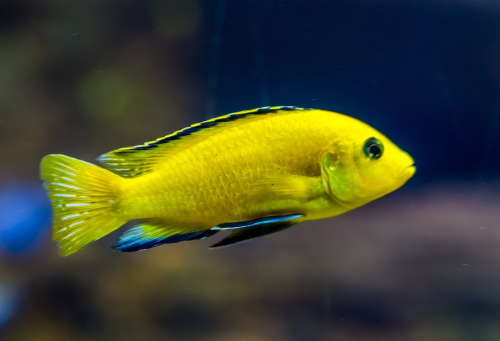
- Scientific Name: Neolamprologus leleupi
- Adult Size: 3.9 inches
- Compatible With: Leopard Puffer
- Care Level: Difficult
- Origin: Burundi, Tanzania, Democratic Republic of the Congo, Zambia
These cichlids are best kept in pairs with one another. They can be difficult to keep, but last a long time, living for up to ten years.
The lemon cichlid is named for its bright yellow coloration. It is both bold and large enough to avoid becoming the puffer’s snack!
Pros of keeping with Leopard Puffer:
- No food competition
- Bold enough to avoid being eaten
Cons of keeping with Leopard Puffer :
- Chance of aggression with tank mates
4. Guppy
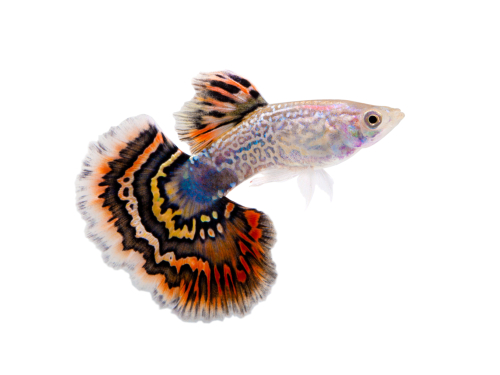
- Scientific Name: Poecilia reticulata
- Adult Size: 2 inches
- Compatible With: Leopard Puffer
- Care Level: Easy
- Origin: South America
Unlike many of the fish on this list, a Guppy can actually be kept in a tank with relative ease! They are very small and startlingly beautiful. Guppies come in many different beautiful colors.
They are typically quite peaceful and pose no threat to the food of the Leopard Puffer; however, without groups of their own to school in and places to hide, there is a chance that the leopard puffer could eat a guppy.
Pros of keeping with Leopard Puffer:
- No food competition
- Will not attack Leopard Puffer
Cons of keeping with Leopard Puffer :
- Can be in danger without school or places to hide
5. Archerfish
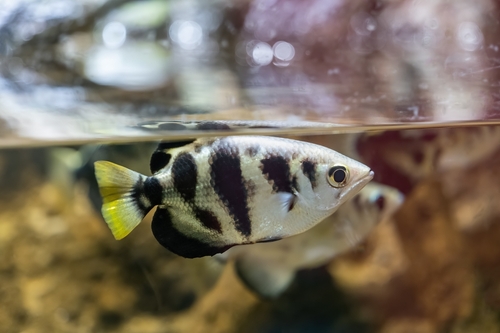
- Scientific Name: Toxotes jaculatrix
- Adult Size: 12 inches
- Compatible With: Leopard Puffer
- Care Level: Medium difficulty
- Origin: China, Thailand, Malaysia, Palau, Philippines
Archerfish are big fish; much too big to be bullied by your Leopard puffer! They like to eat in the upper part of the tank and enjoy plants to swim around.
Archerfish are also called Banded Archerfish. They have a sleek profile with silver scales, banded by cloudy black markings.
Pros of keeping with Leopard Puffer:
- No food competition
- Too big to be eaten
Cons of keeping with Leopard Puffer :
- Large amount of tank space required
6. Sailfin Molly

- Scientific Name: Poecilia latipinna
- Adult Size: 3 inches
- Compatible With: Leopard Puffer
- Care Level: Easy
- Origin: Louisiana
Sailfin mollies should be added to a tank for interesting looks, alone! This fish is silver but speckled all over, even on its enormous fin shaped like the sail of a boat.
Sailfin mollies may be slightly smaller than a Leopard puffer, but with enough room to maneuver and places to keep out of the puffer’s eyeline, there should be little trouble.
Pros of keeping with Leopard Puffer:
- No food competition
Cons of keeping with Leopard Puffer :
- Can be a risk of infighting without enough room
7. Orange Chromide
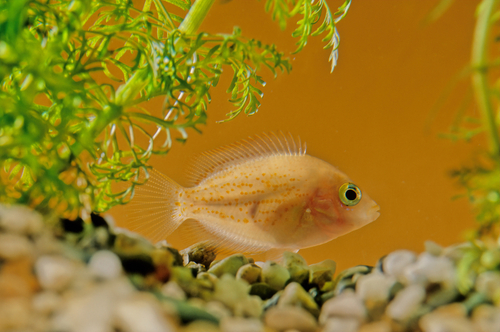
- Scientific Name: Etroplus Maculatus
- Adult Size: 3 inches
- Compatible With: Leopard Puffer
- Care Level: Easy
- Origin: Sri Lanka
This fish is well known for being incredibly peaceful. It does not cause trouble or start fights, and enjoys the community of other fish in the tank.
The orange chromide does not often get along with fish that are much larger than it, but as long as there are plenty of obstacles and room in the tank, the silvery orange omnivore won’t be too bothered by the Leopard puffer!
Pros of keeping with Leopard Puffer:
- No aggression
- No food competition
Cons of keeping with Leopard Puffer :
- Without room, can be preyed upon
8. Leaf Fish
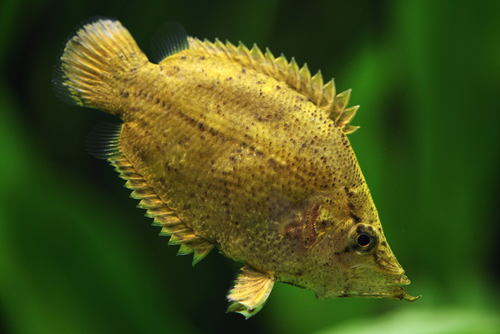
- Scientific Name: Monocirrhus polyacanthus
- Adult Size: 4 inches
- Compatible With: Leopard Puffer
- Care Level: Difficult
- Origin: South America
Though this fish can be described as hard to care for in terms of water conditions, it is worth it to have such an interesting specimen in your tank. Leaf fish may escape the notice of a hungry leopard puffer because they look like submerged, swimming leaves!
It is, however, not a peaceful fish. The Leaf Fish is a predator that lies in wait and can eat its own weight in food every day. Thanks to the Leopard Puffer’s size and the Leaf Fish’s ability to hide, they may not bother one another.
Pros of keeping with Leopard Puffer:
- Camouflage may protect from aggression
Cons of keeping with Leopard Puffer :
- Risk of infighting
9. Mudskipper
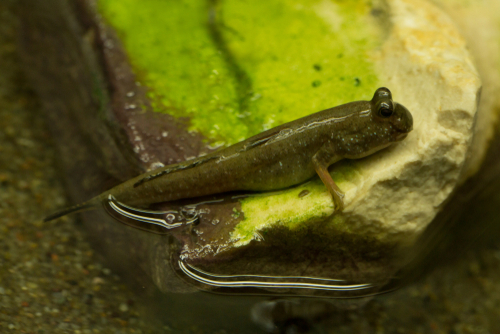
- Scientific Name: Periophthalmus novemradiatus
- Adult Size: 4 inches
- Compatible With: Leopard Puffer
- Care Level: Easy
- Origin: Thailand, Myanmar, Malaysia
The Indian Mudskipper is a prime candidate for being tank mates with a Leopard Puffer. This is because it is capable of living in brackish water. Actually, this fish is famous for being able to hang out on land in limited capacities!
Pros of keeping with Leopard Puffer:
- No food competition
- Capable of hiding from Leopard Puffer
Cons of keeping with Leopard Puffer :
- Risk of infighting
10. Figure 8 Puffer
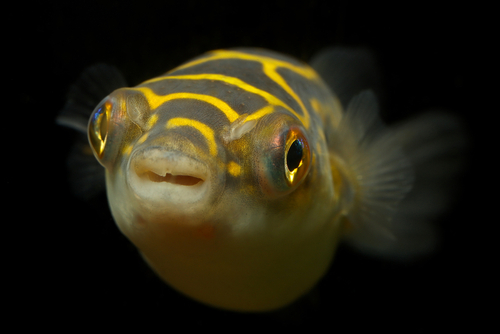
- Scientific Name: Tetraodon biocellatus
- Adult Size: 2 ½ inches
- Compatible With: Leopard Puffer
- Care Level: Medium difficulty
- Origin: Southeast Asia
What’s better company for one puffer fish than another? The Figure 8 Puffer is pretty aggressive and even though it is smaller than the Leopard Puffer, with plenty of room and obstacles, the two may coexist.
These fish are friendly-looking, with yellow and white bodies crisscrossed by beautiful spots that look a lot like the number “8.”
Pros of keeping with Leopard Puffer:
- Can’t be bullied
- No food competition
Cons of keeping with Leopard Puffer :
- Without enough room infighting may occur
11. Goby

- Scientific Name: Elacatinus Oceanops
- Adult Size: 2 inches
- Compatible With: Leopard Puffer
- Care Level: Easy
- Origin: Caribbean
Gobies are delightful fish, and popular because they are easy to care for. They can survive in the brackish water that the leopard puffer needs, and are able to avoid the more aggressive fish.
In addition, there is little food competition from this smaller fish. The Goby is sometimes called “neon” for the vibrant colors and bright blue stripe it carries.
Pros of keeping with Leopard Puffer:
- No food competition
Cons of keeping with Leopard Puffer :
- Risk of being eaten without enough room
12. Wrestling Halfbeak
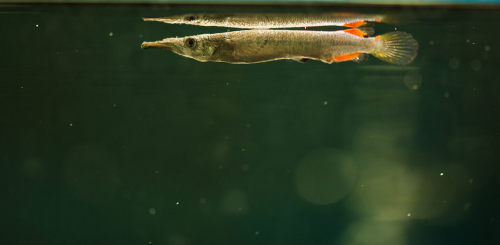
- Scientific Name: Dermogenys pusilla
- Adult Size: 3 inches
- Compatible With: Leopard Puffer
- Care Level: Easy
- Origin: Thailand
The wrestling halfbeak should get points just for its unique name! It is a type of fish that can live in the same half-salt water conditions as the leopard puffer.
This fish likes to be kept with other species that are similar in temperament; it is peaceful by nature and shy. However, it eats only at the surface, and does not prefer dry foods. Because of this, the slender, brown fish will avoid being bullied by the puffer.
Pros of keeping with Leopard Puffer:
- No food competition
Cons of keeping with Leopard Puffer :
- Shy, may be eaten
13. Flower Horn Cichlid
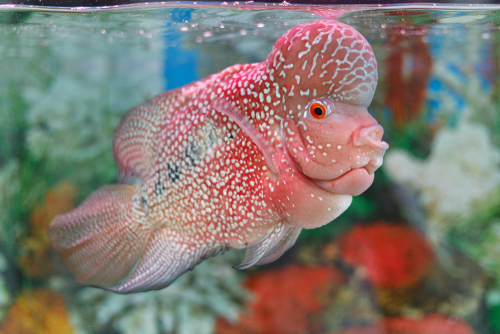
- Scientific Name: Amphilophus hybrid
- Adult Size: 12 inches
- Compatible With: Leopard Puffer
- Care Level: Easy
- Origin: Man-made
This fish is easy to care for and may be an attractive addition to your puffer tank. This is especially because the Flower Horn Cichlid is too large and adventurous to be bullied by the puffer.
This fish is usually brightly colored in warm tones. It was bred for a funny, characteristic protuberance on its forehead!
Pros of keeping with Leopard Puffer:
- No food competition
- Too big to be eaten
Cons of keeping with Leopard Puffer :
- May engage in infighting
14. Balloon Molly
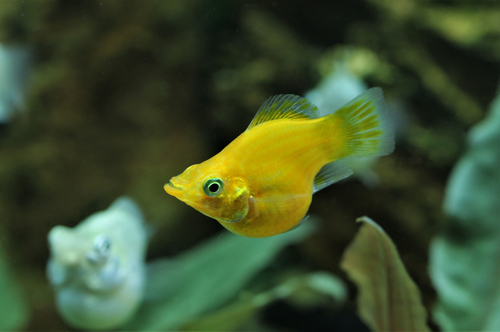
- Scientific Name: Poecilia latipinna
- Adult Size: 3 inches
- Compatible With: Leopard Puffer
- Care Level: Easy
- Origin: Central America
The Balloon Molly is named for its pot-belly appearance, which is actually the result of a spine deformity caused by the species’ genes. Otherwise, it is too large to be bullied by a leopard puffer.
This fish eats a wide diet and is otherwise very easy to care for. It is also pleasing to look at, a summery orange in color.
Pros of keeping with Leopard Puffer:
- No food competition
- Too big to be bullied
Cons of keeping with Leopard Puffer :
- Risk of infighting
15. Dalmatian Molly

- Scientific Name: Poecilia latipinna
- Adult Size: 5 inches
- Compatible With: Leopard Puffer
- Care Level: Easy
- Origin: South America
The Dalmatian molly is a beloved fish because it is very simple to care for. Like the spotted dog it is named for, Dalmatian mollies are white with spots.
This fish is another that is too large to be eaten by the puffer, and it is also naturally peaceful by nature.
Pros of keeping with Leopard Puffer:
- Too large to be eaten
- No food competition
Cons of keeping with Leopard Puffer :
- Risk of infighting
In Conclusion
To sum everything we’ve learned up, the 15 best leopard puffer tank mates are fish like Clown Fish who are large enough to avoid being eaten by the highly aggressive and carnivorous Puffer. Other good tank mates include fish that occupy sheltered zones of the tank or are simply provided with enough room to escape the leopard puffer!

Ian Sterling, founder of Fishlab.com, began his aquarium journey over 30 years ago, driven by a deep fascination for fish and their diverse personalities. His website, Fishlab.com, is dedicated to making fishkeeping accessible and enjoyable, offering beginner-friendly guidance, expert insights, and a community for aquarists to connect and share experiences.


